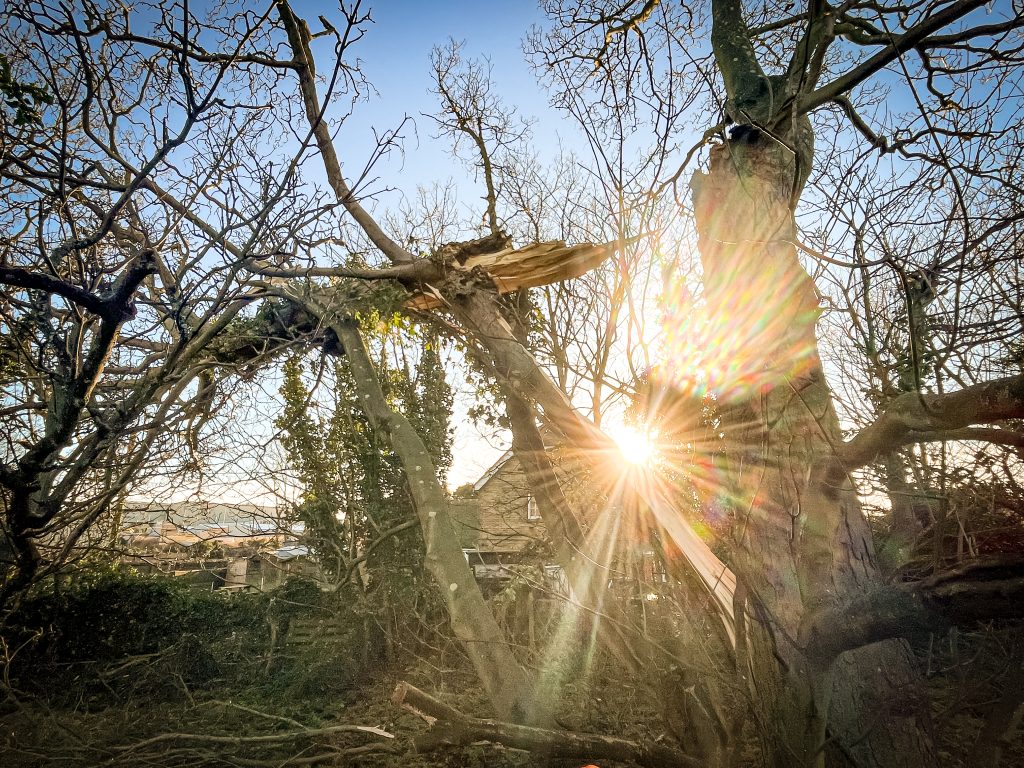
Case Study: Storm Damage Assessment and Tree Removal at Nash Court Farm
Client: St James College, University of Cambridge
Location: Nash Court Farm, near Nash Cottages, Thanet
Issue: A large sycamore tree (Acer pseudoplatanus) located on the boundary of Nash Court Farm, adjacent to Nash Cottages, suffered significant storm damage. The tree’s compromised condition posed a potential hazard to nearby structures and required immediate attention to ensure the safety of the surrounding area. Additionally, the presence of important fiber optic overhead cables in close proximity added complexity to the situation.
Actions Taken:
1. Initial Assessment: Upon receiving the request from St James College, a team of arborists and safety specialists was dispatched to Nash Court Farm. The team conducted a thorough assessment of the storm-damaged tree, evaluating the extent of the damage and identifying potential risks. Special attention was paid to the proximity of fibre optic overhead cables, highlighting the need for precise planning to avoid damage to critical infrastructure.
2. Safety Precautions: Given the size and condition of the tree, as well as the presence of overhead cables, safety precautions were paramount. Exclusion zones were established around the work area to prevent unauthorized access, and all personnel were equipped with appropriate safety gear. Communication with utility companies responsible for the fibre optic cables was initiated to coordinate efforts and ensure their protection during the tree removal process.
3. Specialist Access Equipment: Recognising the need for elevated working to safely address the hung-up section of the tree and the compromised standing stem, specialist access equipment was organised. A tracked Mobile Elevated Work Platform (MEWP) was selected to provide the necessary reach and stability for the arborists to carry out their work safely.
4. Cutting and Clearing: With safety measures in place and specialist equipment deployed, the arborists began the process of cutting and clearing the storm-damaged tree. Careful consideration was given to the location of the fiber optic cables, with precise cutting techniques employed to minimise the risk of damage. The operation proceeded methodically, with close monitoring of the surrounding area to ensure the safety of nearby structures and personnel.
5. Follow-Up Inspection: Following the successful removal of the storm-damaged tree, a follow-up inspection was conducted to assess the effectiveness of the operation and address any remaining concerns. The integrity of the fibre optic cables was verified, and any potential impacts from the tree removal were mitigated.
Outcome:
Through careful planning, precise execution, and close collaboration with stakeholders, including St James College and utility companies responsible for the fibre optic cables, the storm-damaged tree at Nash Court Farm was safely removed without incident. The surrounding area was secured, and the integrity of critical infrastructure was preserved, ensuring the continued safety and functionality of the site.
Lessons Learned:
This case highlighted the importance of proactive risk management and collaboration in addressing emergency situations such as storm damage. By prioritising safety, communication, and careful planning, potential hazards can be effectively mitigated, protecting both people and property in the process. Additionally, the experience underscored the significance of considering the presence of critical infrastructure, such as fibre optic cables, in outdoor maintenance operations, and the need for specialised expertise to navigate such challenges successfully.
